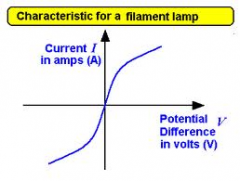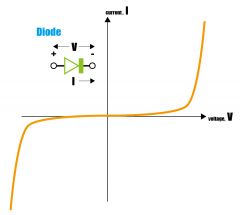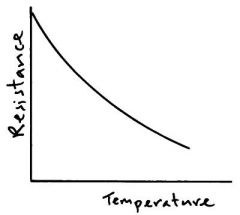![]()
![]()
![]()
Use LEFT and RIGHT arrow keys to navigate between flashcards;
Use UP and DOWN arrow keys to flip the card;
H to show hint;
A reads text to speech;
61 Cards in this Set
- Front
- Back
|
Definition of an electric current
|
Rate of flow of charge
The number of electrons which pass a point every second |
|
|
Unit of electric current
|
Amperes
|
|
|
Symbol of electric current
|
I
|
|
|
How is charge carried in a metal?
|
Electrons
|
|
|
How is charge carried in salt solution?
|
Ions
|
|
|
Why don't insulating materials carry an electric current?
|
Charge carriers (electrons) are held fixed in place to an atom.
|
|
|
How does a battery establish an electric current?
|
Forces the charge carriers to move in one direction only.
|
|
|
At what temperature do electrons vibrate and become detached? What is the advantage of this?
|
Absolute zero
Free to move and thus carry an electric current - act as charge carriers |
|
|
In what direction do electrons pass round any circuit? (opposite to truth)
|
Positive to negative
|
|
|
Definition of charge
|
Amount of charge passing a point when the current is exactly 1A
How strongly a circuit experiences an electromagnetic force. |
|
|
Unit of charge
|
Coulombs
|
|
|
Symbol of charge
|
Q
|
|
|
Definition of potential difference/voltage
|
Electrical energy converted into other forms of energy when 1 coulomb of charge passes through one point to another.
|
|
|
Unit of potential difference
|
Voltage
|
|
|
Symbol of potential difference
|
V
JC^-1 |
|
|
What do voltmeters do?
|
Measure potential difference between two points in a circuit
|
|
|
What happens to the charge carriers if there is no potential difference?
|
Move about at random
|
|
|
Definition of power
|
Rate of transfer of energy
|
|
|
1 watt is equivalent to
|
1 joule per second
|
|
|
Unit of power
|
Watts
|
|
|
Definition of energy
|
Work done
|
|
|
Unit of energy
|
Joules
|
|
|
Symbol of energy
|
E
|
|
|
Symbol of power
|
W
|
|
|
Keyword for when a component converts electrical energy into other types of energy
|
Power dissipation
|
|
|
Definition of resistance
|
Measure of the impedance of charge carriers, opposing the passage of an electric current
|
|
|
What is the inverse of resistance?
|
Conductivity
|
|
|
Units of resistance
|
Ohms
|
|
|
What does a shallow gradient of a I/V graph tell you?
|
High resistance within component
|
|
|
What does Ohm's law state?
|
Provided the temperature is constant, the current is directly proportional to the voltage across it.
|
|

What does this graph show?
|
Constant resistance - steady gradient
Current is directly proportional to voltage Follows Ohm's law |
|

What does this graph show?
|
Resistance changes - gradient curves (varies)
As the current rises the metallic filament in the bulb heats up and so resistance increases. Charge carriers gain kinetic energy and as a result collide more frequently Non ohmic |
|
|
Definition of conductance
|
How well a component in a circuit conducts electricity
|
|
|
Units of conductance
|
Siemens (S)
|
|
|
Symbol for conductance
|
G
|
|
|
1S is equivalent to
|
AV^-1
|
|

What does this graph show?
|
Resistance varies (curve)
Resistance is very high in one direction - little current for a high voltage Resistance decreases as current rises Diodes only allow current to pass in one direction - forward direction Non ohmic |
|

What does this graph show?
|
Resistance depends on temperature
Gradient varies (curve) general increase As temperature increases the resistance is lower Electrons inside thermistor gain more kinetic energy and as a result have enough energy to escape from their atoms and act as charge carriers - resistance lowers. Non ohmic |
|
|
Sensitivity =
|
Change in output/change in input
|
|
|
Explanation of resistance
|
Charge carriers colliding and as a result losing energy
|
|
|
Why do batteries and cells warm u when being used?
|
Internal Resistance
|
|
|
What does a potentiometer/rheostat do?
|
Varies resistance
|
|
|
What two factors increase the resistance of a uniform metal wire?
|
Length - greater distance to travel; charge carriers experience more collisions with fixed atoms. Kinetic energy is passed on and fixed atoms vibrate more
Diameter - smaller space for charge carriers to pass through and as a result experience more collisions with fixed atoms. Decreases number of charge carriers available.Kinetic energy is passed on and as a result fixed atoms vibrate more, increasing resistance. |
|
|
Definition of electromotive force
|
Amount of energy a battery produces for each coulomb of charge
|
|
|
Units of electromotive force
|
Voltage
|
|
|
Definition of load resistance/external resistance
|
Total resistance of all components in the external circuit
|
|
|
Define terminal potential difference
|
Potential difference across load resistance
Maximum voltage |
|
|
If there was no internal resistance the terminal potential difference would be the same as the
|
electromotive force
|
|
|
Define lost volts
|
Energy wasted per coulomb overcoming the internal resistance
|
|
|
Electromotive force =
|
lost volts (v) + terminal potential difference (V)
|
|
|
lost volts =
|
current x internal resistance
|
|
|
Why are High Tension supplies safer?
|
Have very high internal resistance and so if device is short circuited only a small current can pass through
|
|
|
What is a short circuit?
|
When current travels along an unintended path where there is no electrical impedance.
|
|
|
Rearrange V = E - Ir to find the equation of a straight line
|
V = Ir + E
E = intercept, constant I = gradient r = constant |
|
|
The total current entering a junction =
|
total current leaving junction
|
|
|
The total emf around a series circuit =
|
sum of p.d across each component
|
|
|
Voltage and current in a series circuit:
|
Current is the same at all points because there are no junctions
Electromotive force is split between all components |
|
|
Current and voltage in a parallel circuit:
|
Current is split at each junction
Voltage is the same across all components |
|
|
Equations for the shared voltage in series circuits
|
V = V1 + V2 + V3
IR = IR1 + IR2 + IR3 |
|
|
Equations derived from shared current in parallel circuits
|
I = I1 + I2 + I3
V/R = V/R1 + V/R2 + V/R3 |
|
|
Potential difference formula=
|
Vout = [R1/(R1 + R2)] x Vin
|

